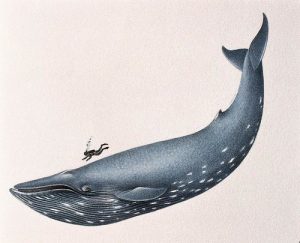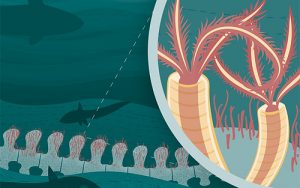With an average weight of 330,000 pounds and a vocalization of up to 188 decibels (which can be heard 160 kilometers away), the blue whale stands as the largest and loudest animal on Earth. Their enormous hearts beat from the Pacific to the Atlantic and anyone who has had the luck of seeing them in person can testify to their splendor. These creatures, like many other species of whales, have a graceful aura despite their enormous size and humans have grown to marvel at them for decades. Yet, due to our focus on the living component of a whale’s existence, research on what happens after their lifetime is at most 44 years old! Only recently have we begun to answer questions like: where does a tremendous being go after its heart stops for good? It turns out that if a whale’s body doesn’t wash ashore or get caught by humans, it brings life to nutrient-deprived areas of the ocean floor called deep-sea bottoms and can nurture a community of marine organisms for generations to come. This process that turns a whale’s death into a blooming ecosystem is called a Whale Fall, and the newly formed habitat shifts and evolves in ways that can only be described as fascinating, yet, simultaneously disturbing. The slow decomposition of a whale’s carcass is divided into four phases (mobile scavenger, enrichment-opportunist, sulphophilic, and reef), each lasting from a few months, up to a century. Every phase ultimately results in decades of sustenance for many deep sea-dwelling creatures, turning a depressing topic into an interesting phenomenon.

Every specimen from each species must embark on a final journey; whales eventually give their final bow, and then begin their voyage down into colder ocean waters. The physical descent can be comprehensible, since it isn not complicated to imagine a heavy object sinking, but the time spent descending depends solely on wherever the body starts falling. Since the carcass can drop for distances that range from ~ 50 meters to 2900 meters, the time it takes for a carcass to reach the ocean floor varies based on location. Currents sway the massive bodies down until they literally hit rock bottom, and the mobile scavenger stage begins, where larger scavengers start consuming the remains.
Once their enormous bodies hit the soft mud of the ocean’s inky depths, there is a small window of time before the mass starts attracting nearby mobile predators such as hagfish, rattails, octopuses, and sharks. These organisms are called necrophages during this first stage, they manage to eat most of the whale’s soft tissue–muscles, internal organs, and the blubber that holds them together–consuming 40 to 60 kilograms every day from 5 months to 5 years. Of course, this time depends on the size and condition of the whale upon its arrival to the bottom, but it still feeds the necrophages for a significant amount of time. After multiple meals have been taken out of the carcass, the huge white bones are merely adorned with scraps of meat and fat for smaller decomposers like tanner crabs and giant isopods to scout.
Although the inky depths of the ocean floor make it impossible to see the first phase without an extraordinary flashlight, there are a myriad of colors and shapes that have made the whale’s body their home. Small Muusoctopi dangle from the bones like purple dots, Pom-Pom anemone adorn the bones with their seemingly fuzzy pink bodies, and eelpout fish roam the whale’s structure as if they own it. But there’s something more happening during this first phase, and it has to do with the way these creatures consume the whale’s tissues.
It’s safe to say that we don’t expect a shark to be gentle with its meal, especially when they live in an environment with limited resources. The same goes for the other mobile necrophages who tear through the tissue with sloppy and aggressive motions. Yet, this is extremely beneficial for the ocean as a whole! This way of eating releases tissue into the ocean that gets carried away by currents, helping to feed even more deep-sea creatures miles away from the carcass itself. Aguzzi, et al (2018) describe how “a 40-ton sunken adult whale provides an enormous input of organic matter.” This matter equates to 200 years of nutrients arriving at the seafloor through the natural flux of marine snow (feces, bacteria, planktonic skeletons, etc). So, one whale can support the entirety of an environment’s benthic and nektonic–referring to organisms that live on a bottom surface, and species that can swim against the currents of the ocean, respectively–biodiversity for decades while in its very first stage of decay!
Transitioning back to the whale’s decay: once those final bits and pieces are out of the way, all that remains are a few animals, hoping to find something to nibble on. In the meantime, worms, smaller crustaceans, and other life forms start colonizing the body to ingest the rich sediment surrounding the bones. This is the enrichment-opportunity stage, and it looks like the body has been surrounded by a bleached carpet of life. Hundreds of bristle worms (polychaetes) pile around the whale’s remains like a field of white grass. The bones are also covered by a variety of enclosed-shell mollusks and polychaetes. All of these organisms paint a very unusual picture: a bed of white under an immense organic structure, which will supply necessary resources to its new hosts for up to two years.
After decades of tedious decomposition, one may think that the process of decomposition is done and the carcass is nothing more than a useless pile of bones. That would be wrong; there are still roughly 7,700 pounds of unblemished organic matter on the whale’s bones that could not go to waste, and Osedax worms, clams, and bacteria would agree. As it turns out, these critters will be the next guests of the whale’s remains, coating the surface in thin red strands or chunky crustacean bodies, as they break down the lipids within the fatty bones and begin the sulphophilic stage. Hundreds of seemingly red hairs shooting up at the surface coat the whale’s bones, giving the illusion of leftover muscle, but in reality, every filament is an Osedax worm (a.k.a bone worms).

Osedax worms–like other creatures at this stage–are fascinating specimens. Observed in the Whale Falls, they slowly decompose the bones, releasing sulfides and methane in the process. We previously saw how the release of tissue into the ocean currents granted an immense amount of biomass that could feed marine heterotrophs (beings that rely on external food sources for survival), but by producing methane and sulfides, this stage’s bacteria and worms release nutrients essential to the survival of chemolithoautotrophic organisms. Chemolithoautotrophs are organisms that obtain inorganic compounds from their environment in order to fulfill metabolic needs. This means that when deep-sea creatures such as Osedax worms eat away at the whale’s bones, they are not only feeding themselves but are releasing the essential nutrients needed by chemolithoautotrophs! Any assumption that Whale Falls could only benefit heterotrophs is blown away as the phenomenon also contributes towards maintaining the diversity of chemolithoautotrophic life in deep-sea environments.
Okay, how about now? Are we finally at the end of this whale’s existence? The answer might be underwhelming, but we don’t know. While we have speculations as to what happens after the first three stages, the reality is that we haven’t been actively researching these falls enough to gather all the necessary data. However, there is a hypothesis about the later decomposition of whale carcasses. In 2003, a final stage in the Whale Fall was proposed: the reef stage, where, after the complete depletion of organic components, the mineral remains are overrun by suspension feeders (animals that feed on nutrients suspended in the water) who exploit what’s left. However, nothing is set in stone and as more scientists explore the otherworldly phenomenon, further groundbreaking discoveries will be made. Already numerous new species have been cataloged just by examining whale falls, and there’s a myriad of open questions left in this field. Yet, it is commendable how in so little time we have honed in on essential features of what happens to the largest beings to ever roam the Earth after death. Hopefully, the increase in Whale Fall research will provide a better understanding of these vastly complex biological processes that occur on our planet.
The topic of Whale Falls is one that has intrigued scientists and general audiences alike. Despite the ‘morbid’ or ‘sad’ nature of the topic, there’s an abundance of people who are interested in developing Whale Fall research. In part, it could be because of innate curiosity, but overall I think this topic allows us to explore death in an alternative manner. Although there’s no need to shy away from the fact that every organism will cease to live, death is an understandably hard topic to tackle. However, talking and researching about Whale Falls reminds us of the importance that a single life can have in the flow of nature; or rather the importance of a single death. The fact that one death can bring so many necessary nutrients for the development of hundreds of organisms is a miracle. And by looking at it from that perspective, what was once saddening and confusing can be understood under a more optimistic light.
References:
- https://www.amazon.com/000-Leagues-Undersea-Submariner-Submergence-ebook/dp/B00VERWICQ
- https://www.fisheries.noaa.gov/species/blue-whale
- https://oceana.org/marine-life/blue-whale/
- http://sitkawhalefest.org/wordpress/wp-content/uploads/2013/12/Diva_Paper2.pdf
- https://www.nature.com/articles/s41598-018-29431-5.pdf?origin=ppub
- https://books.google.com/books?id=64crGFXWn5gC&pg=PA311#v=onepage&q&f=true
- https://www.soest.hawaii.edu/oceanography/faculty/csmith/Files/Smith%20and%20Baco%202003.pdf
- https://nmssanctuaries.blob.core.windows.net/sanctuaries-prod/media/mag/5/whale-fall-poster-noaa-onms.pdf
- https://www.sciencefocus.com/nature/whats-the-loudest-animal-relative-to-its-size/